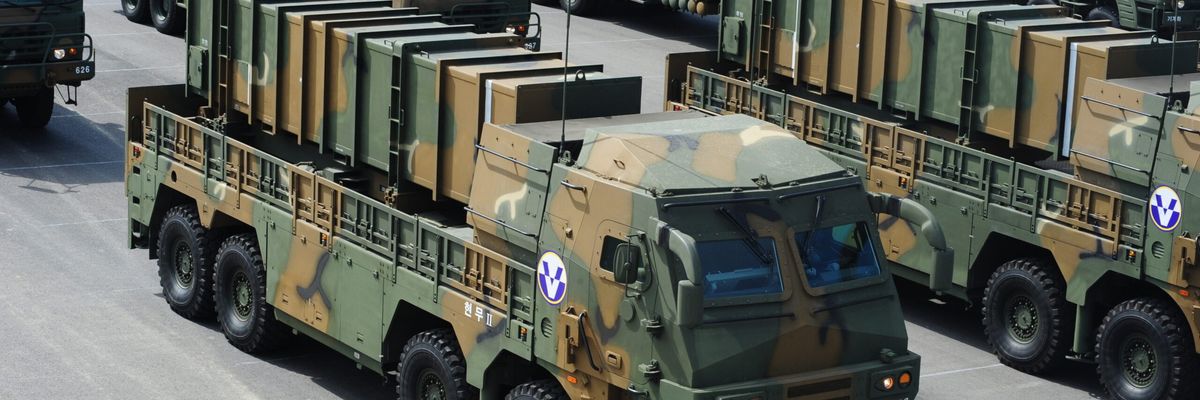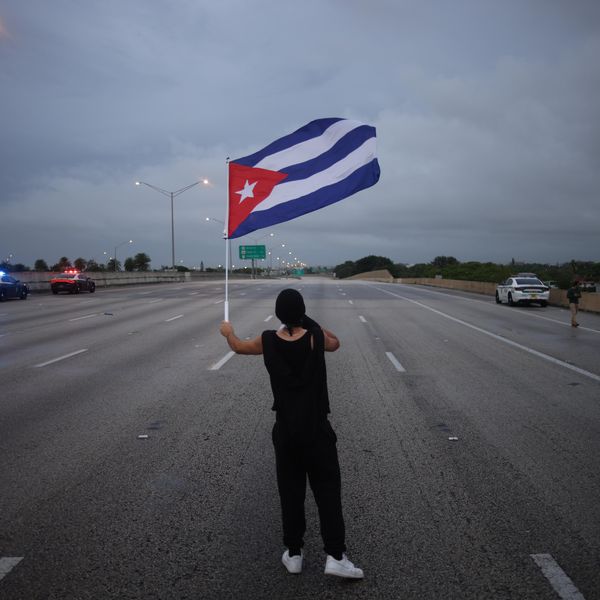This article has been republished with permission from International Crisis Group.
In the autumn months, the two Koreas put on something of a military show for the world. As they flexed their muscles – testing missiles and displaying new capabilities – commentators speculated about an accelerating arms race and wondered whether the peninsula might be headed for a crisis moment after several quiet years. Since North Korean leader Kim Jong-un and U.S. President Donald Trump exchanged taunts in 2017, including Trump’s famous threat to rain down “fire and fury” if Kim crossed his red lines, the peninsula has been relatively calm. But while the possibility of a sudden escalation in tensions can never be fully dismissed, particularly given North Korea’s penchant for wilfully unpredictable behaviour, the autumn’s activity does not necessarily augur a spike in near-term instability. It does, however, suggest that the two sides are positioning themselves for potentially consequential changes on the peninsula as South Korea’s 2022 national elections approach, Seoul and Washington jostle for operational control over their combined forces, and Pyongyang contemplates a new push to achieve its stymied strategic and economic objectives.
Much of the two sides’ showmanship took place in September and October. At first, the action was outdoors. North Korea conducted cruise missile tests on 11 and 12 September, a short-range ballistic missile test from a train three days later, and what the North claimed was a hypersonic missile test, of the Hwasong-8, late in the month. For its part, on 15 September, South Korea became the first non-nuclear state to test a submarine-launched ballistic missile. Then, in October, some events moved indoors, with back-to-back exhibitions in Pyongyang and Seoul showcasing some of both countries’ newest weaponry. North Korean state media reported on Self-Defence 2021, a celebration of new defence technology, which it hosted at the Three Revolutions Exhibition for several days beginning on 11 October. Shortly thereafter, from 19 to 24 October, South Korea held its International Aerospace and Defence Exhibition 2021 at Seoul Airport, a military base operated by its air force. At the same time, Seoul took a highly symbolic step, launching its first entirely indigenous rocket, the Korea Space Launch Vehicle-II, also known as Nuri-ho.
[T]hese parallel shows of strength can be viewed as part of a contest for military supremacy on the peninsula.
To some extent, these parallel shows of strength can be viewed as part of a contest for military supremacy on the peninsula. With Pyongyang continuing to develop its missile and nuclear capabilities, and Seoul demonstrating technological leaps of its own, both sides have reason to want to keep pace. But they were also driven by broader agendas.
For Seoul, displays of technological prowess have multiple audiences. On the economic side, South Korean companies generate considerable revenues from arms sales to overseas buyers in South East Asia, as well as Europe and, in a $700 million deal inked on 13 December, Australia. Regional customers have long looked to the South for competitively priced armoured vehicles and training aircraft. As for the strategic implications of showing off new armaments, it is a way of demonstrating to both domestic and international observers that South Korea’s political and defence establishments are working to develop military capabilities that will make the country less dependent on the United States. This is partly an outgrowth of the downturn in relations with Washington during the Trump administration, which pushed the South to pay much more for the U.S forces stationed there. Since President Joe Biden took office in January, the U.S.-South Korea alliance has been much more stable, as demonstrated in March by the painless conclusion of a new agreement on how to split the bill for the U.S. garrison. Nevertheless, South Korean policymakers know that polarised politics in the U.S. makes the latter less than perfectly reliable. In planning for the future, they must account for the possibility that U.S. voters will again elect a president who takes a Trump-like transactional approach to the alliance.
The South’s left-leaning Democratic Party, led by President Moon Jae-in, has still other reasons for wanting to show the U.S. its growing military prowess. Under current arrangements between the U.S. and South Korean militaries, the U.S. would take command of both U.S. and South Korean forces in the event of war with the North. Seoul has long, if fitfully, sought Washington’s agreement to transfer wartime operational control to South Korea, seeing this authority as a matter of national sovereignty. Moon and his party have made this issue a particular priority. If their efforts succeed, command of the South Korean military would rest with Seoul, even if shooting starts, for the first time since July 1950.
The Biden administration took a step toward allowing Seoul greater autonomy over its own defences in May, when the two sides quietly terminated limits first imposed on the range of South Korean missiles in 1979 as part of a deal that gave the South access to U.S. missile technology, but which had outlived their usefulness in the face of the North’s rapid missile development. Seeing this step as a sign of momentum, President Moon (who cannot seek another term in office) believes that his successor – to be elected when South Koreans go to the polls in March 2022 – will be positioned to conclude a deal for the transfer of operational control. On 2 December, when U.S. Defense Secretary Lloyd Austin visited South Korea for the annual U.S.-Republic of Korea Security Consultative Meeting, the Moon administration even broached the idea of accelerating an assessment of South Korean readiness for the transfer. (That assessment is presently planned for the summer of 2022.) Thus, by displaying new technological capabilities in September and October, Seoul was showing Washington that South Korea has not only the political will but also the technological capacity to defend itself, a key prerequisite for the transfer of authority.
North of the demilitarised zone, meanwhile, Pyongyang seems to be rebooting a familiar strategy by which it incrementally raises tensions with Seoul and Washington for diplomatic leverage. To the extent that it has begun stepping out beyond its practice of testing and perfecting weapons systems (North Korea laid out its top five priorities for the strategic weapons sector – including cruise missile development – at the 8th Korean Workers’ Party Congress in January), the North’s return to military posturing may be intended to begin the process of re-establishing the Korean situation’s prominence as a central international issue. It yielded this position during the North’s period of diplomatic engagement with the U.S. and the South starting in January 2018. Displays of warm personal relations between Trump and Kim – even described in the press as a “bromance” – cooled somewhat after their summit at Hanoi in February 2019 broke up without a breakthrough on Pyongyang’s twin aims of getting UN sanctions lifted and reducing what it sees as the U.S. threat on the peninsula. But, in the interim, Washington and Pyongyang have nevertheless each shelved, steered clear of or scaled back activities that the other finds especially provocative, including certain drills on the U.S. and South Korean side and nuclear tests and missile tests beyond a certain range on the North Korean side.
President Biden appears to hope that things stay this way. Since taking over, the Biden administration has indicated that North Korea is not a high priority in U.S. foreign policy. Against this backdrop, Pyongyang’s autumn spate of missile tests can probably best be seen as calibrated to put itself back on the diplomatic map without triggering a meaningful international response, by remaining below the level of provocation that would have prompted one. North Korea’s ballistic missile launches of 15 September can also be seen as a form of protest against Chinese Foreign Minister Wang Yi’s visit to Seoul around the same time.
The South does not feel it has total clarity about U.S. alliance commitments.
Whether or not Pyongyang turns up the temperature further will likely depend on developments in both Koreas. Looking to the South, on 10 October, the Democratic Party selected its candidate to succeed President Moon. The nominee, Lee Jae-myung, is mayor of a satellite city of Seoul. He declared back in August that, if elected, he would seek sanctions waivers for North Korea at the UN to allow the reopening of the Kaesong Industrial Complex, a joint North-South manufacturing zone just north of the shared border that has been shut down since February 2016. On 5 November, the conservative People Power Party also chose its presidential candidate: Yoon Seok-yeol. Unlike Lee, Yoon is inclined toward containment of North Korea and a renewed emphasis on its denuclearisation, which is likely to result in raised inter-Korean tensions. If elected, Yoon will almost surely pay lip service to political engagement with the North, promoting the notion of a principled engagement policy that conservative rhetoric asserts can push Pyongyang toward economic reform and opening. But he is unlikely to try to dismantle existing barriers to economic cooperation. For this reason, the North may be more inclined to give Lee some breathing space before escalating tensions significantly and less inclined to do the same for Yoon.
Moreover, the North is also facing constraints that limit its immediate options. A strict border regime designed to halt the spread of COVID-19 has denied entry to all people and most goods since the end of January 2020, thrusting North Korea into an economic malaise that will to some degree influence its ability to launch a provocation cycle. While the challenges of access to reliable data, exacerbated by a diminished foreign presence in Pyongyang, make it harder than ever to assess how long the downturn will last, it is clear that the near-term prognosis is not good. Equally, any serious escalation is unlikely to happen in the next few months, because China wants the 2022 Winter Olympics (beginning 4 February and ending 20 February) to go smoothly and will not welcome too much acting out by North Korea in the interim.
Against this backdrop, there is little cause to believe that the current trajectory points toward a return to the 2017 “fire and fury” period, when the war of words between Trump and Kim gave the impression that conflict on the peninsula could be imminent. But risks remain to the regional order that has undergirded peninsular stability. The South does not feel it has total clarity about U.S. alliance commitments. The North is leery of its ever-deepening economic and political reliance on China. Worse, North Korea feels that it reaped no reward for its diplomatic outreach in 2018 and 2019. Though its next steps are always unpredictable, and the pandemic has only made them more so, Pyongyang will likely be tempted to take a different path if it fails to attract the international engagement it desires when it is ready to talk. That temptation will be greatest if the right wins the South Korean presidential election, with the Olympics in the rear-view mirror, and once the pandemic is under a measure of control. While there is no guarantee that the U.S. and the South will be able to forestall that outcome with a diplomatic surge at the right moment, both the Biden administration and the two contenders for South Korea’s presidency should be preparing to try.
















